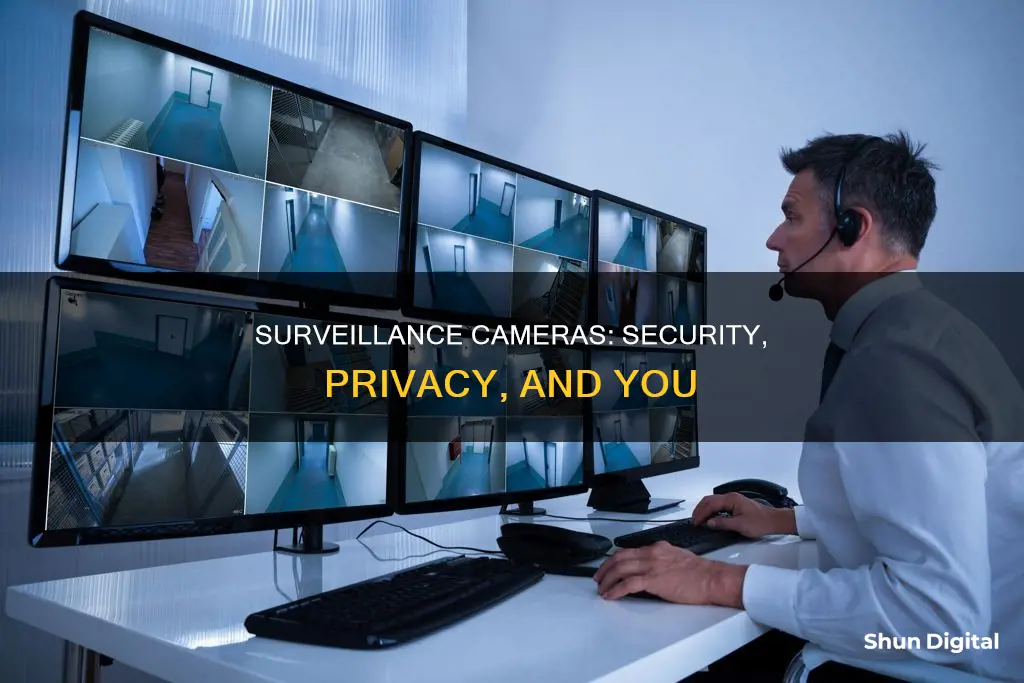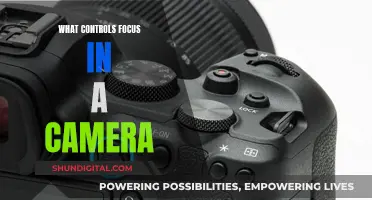
Surveillance cameras are used in public and private spaces to monitor population movements and prevent crime and terrorism. They are placed in areas such as streets, airports, train stations, shops, offices, and people's homes. The footage from these cameras can be used to identify criminals and solve crimes. They are also used by businesses to improve productivity and customer experience, and to prevent theft, vandalism, and sexual harassment. While some people feel safer with the presence of surveillance cameras, others feel that their privacy is being invaded.
| Characteristics | Values |
|---|---|
| Purpose | Monitoring behaviour, activities and information for the purpose of information gathering, influencing, managing or directing |
| Type of Surveillance | Electronic equipment, interception of electronically transmitted information, human intelligence gathering, postal interception |
| Users | Citizens, governments, criminal organisations, businesses, religious organisations, auditors |
| Benefits | Crime prevention, crime investigation, protection of people, groups or objects, intelligence gathering |
| Concerns | Violation of privacy, cost, vulnerability, potential for abuse |
What You'll Learn

Crime deterrence and prevention
Surveillance cameras are an important tool for crime deterrence and prevention. They are often placed in busy areas with high levels of movement, such as crosswalks, malls, parking lots, and airports. The presence of these cameras can deter criminal activity and make it more likely that offenders are identified and caught.
The effectiveness of surveillance cameras in crime deterrence is well-supported by research and real-world examples. According to a University of North Carolina study, 83% of convicted offenders said they would check for the presence of security systems before attempting a burglary, and 60% said they would seek an alternative target if they spotted a camera. This indicates that the mere presence of surveillance cameras can be a significant deterrent to potential criminals.
In addition to deterrence, surveillance cameras aid in the prevention of crimes by helping law enforcement monitor and quickly respond to suspicious activities. For instance, the Boston Marathon bombing suspects were identified and apprehended with the help of video footage captured by the city's surveillance cameras. The use of facial recognition and analytical software further enhances the ability of surveillance systems to predict and prevent criminal behaviour.
Surveillance cameras also play a crucial role in providing evidence during criminal investigations. The clear images and audio capabilities of modern cameras can provide invaluable insights into the series of events, helping law enforcement solve crimes and ensure justice.
While some may argue that surveillance cameras invade privacy, the benefits of these systems in crime deterrence and prevention cannot be overlooked. However, it is important to strike a balance between public safety and privacy concerns. Proper regulations and responsible use of surveillance technology are essential to address privacy issues and ensure that surveillance cameras serve their intended purpose of making our communities safer.
Trail Cameras: American-Made, Quality Assurance
You may want to see also

Evidence gathering
Surveillance cameras are an important tool for evidence gathering in criminal investigations. They can provide invaluable context to detectives working on a case, allowing them to piece together the events leading up to, during, and after an incident. This can include identifying clues such as clothing, faces, and means of escape, all of which can be crucial in solving complex crimes.
The use of surveillance cameras as evidence has become commonplace in criminal cases. Their footage can be highly incriminating if a suspect is clearly distinguishable and can either make or break a prosecutor's case. However, the admissibility of surveillance footage as evidence is subject to certain rules and standards. For example, in Pennsylvania, evidence must be relevant, meaning it has a tendency to make a fact more or less probable and be of consequence in determining the action. Additionally, it must not cause unfair prejudice, confuse or mislead the jury, or result in undue delay.
Surveillance cameras have been instrumental in identifying and apprehending suspects in high-profile cases, such as the Boston Marathon bombing, where investigators sifted through video images captured by the city's cameras to identify the suspects. They can also aid in solving homicides, as demonstrated by the Birmingham Police Department's use of surveillance footage to solve a homicide case.
Beyond criminal investigations, surveillance cameras can also play a role in civil matters. For instance, residents' doorbell camera footage can help increase police patrols and deter crimes like car burglaries and break-ins. This collaboration between law enforcement and the community enhances overall public safety.
The effectiveness of surveillance cameras in evidence gathering is further enhanced by advancements in technology. For instance, some advanced systems can detect and separately identify objects in motion, such as people, animals, and vehicles. They can also be equipped with laser sensors that detect both motion and changes in temperature. These capabilities expand the scope of evidence that can be collected and improve the chances of identifying and apprehending suspects.
However, it is important to acknowledge the potential drawbacks and ethical considerations surrounding the use of surveillance cameras. While they can be a valuable tool for law enforcement, they also raise concerns about privacy invasion and the potential for abuse. Striking a balance between public safety and individual privacy rights is a complex and ongoing debate.
Speeding Camera Tickets: Are They Legally Binding?
You may want to see also

Monitoring scenarios and activities
Surveillance cameras are often placed in busy areas with a lot of movement, such as crosswalks, malls, parking lots, and airports. They are also used in schools, homes, and businesses to prevent crime and terrorism. The footage from these cameras can be used to monitor scenarios and activities, such as:
- Customer traffic and business operations
- Family or children's activities when parents are away
- Daily business practices
- Stock, customer interactions, and other aspects of a business
- Package deliveries
- Visitors to a property
- Abduction cases
Surveillance cameras are useful for monitoring scenarios and activities because they can be placed almost anywhere, are often equipped with motion sensors, and can provide high-quality video and audio recordings. They can also send alerts to the user's smartphone, laptop, or tablet when motion is detected.
Fighting Camera Tickets: Seattle's Guide to Contesting Fines
You may want to see also

Safety and peace of mind
Surveillance cameras are an increasingly popular tool used to monitor population movements and prevent crime and terrorism. They are often placed in busy areas with a lot of movement, such as crosswalks, malls, parking lots, and airports. The presence of these cameras can help deter criminal activity and provide valuable footage in the event of an incident, ultimately improving public safety.
The benefits of surveillance cameras extend beyond crime prevention and into the realm of personal safety. For example, they can help prevent property damage and reduce the risk of trespassing and burglary. According to a study by UNC, outdoor security cameras reduce the chance of property crime by at least half. Additionally, surveillance cameras can provide peace of mind for homeowners and business owners alike. They allow individuals to monitor their property remotely and receive alerts if any unusual activity is detected. This can be especially useful for parents who want to check in on their children or babysitters while away from home.
Surveillance cameras also aid in gathering evidence during legal proceedings. They can provide clear and accurate recordings of events, capturing both video and audio, which can be crucial in resolving disputes and ensuring fair decisions are made.
Furthermore, these cameras assist in maintaining records of daily activities. Homeowners can keep track of visitors to their property, while business owners can monitor stock, customer interactions, and staff activities. This can be valuable for future reference and help with operational decisions.
While surveillance cameras offer numerous advantages, it is important to consider some potential drawbacks. One significant concern is privacy. These cameras can record everyone within their range, including individuals who are not engaging in any illegal or suspicious activities. Additionally, there are costs associated with installing and maintaining security camera systems, and they may be vulnerable to damage or tampering.
Despite these disadvantages, the benefits of surveillance cameras for safety and peace of mind are significant. They play a crucial role in deterring crime, improving public safety, and providing valuable evidence when needed.
Troubleshooting Camera Focus Issues: In and Out
You may want to see also

Cost-effectiveness
Surveillance cameras are an increasingly popular method of crime prevention worldwide. However, their cost-effectiveness is a complex issue that depends on various factors.
The cost-effectiveness of surveillance cameras has been the subject of much debate and research. Some studies suggest that surveillance cameras are cost-ineffective in most areas, while others indicate that they can be profitable in certain locations. The placement of cameras, the type of crime, and the cost of the camera system all play a role in determining the cost-effectiveness of these measures.
One study from Poland found that the municipal CCTV surveillance system was cost-ineffective in most areas analysed. However, it is important to note that the study only considered three categories of street crimes: car burglary/theft, car damage, and robbery. The results may have been different if other types of crimes or social costs had been included in the analysis.
Another study compared the cost-effectiveness of CCTV with improved street lighting and found that there were few situations where CCTV was more cost-effective. The strategy of targeting locations with the highest crime rates, or "hot spots", was found to have the greatest potential for maximising the cost-effectiveness of interventions.
The cost of surveillance cameras can vary widely, from tens to hundreds of dollars per camera. The price depends on factors such as video resolution, field of view, artificial intelligence capabilities, night vision quality, and smart platform integrations. Additionally, there may be additional costs for cloud storage, professional installation, and maintenance.
When considering the cost-effectiveness of surveillance cameras, it is essential to evaluate the potential social costs and benefits. While surveillance cameras can deter crime and provide evidence for investigations, they may also raise concerns about privacy violations and civil liberties.
In summary, the cost-effectiveness of surveillance cameras depends on a multitude of factors, including the specific context, crime types, social costs and benefits, and the effectiveness of alternative measures. While surveillance cameras can be a valuable tool for crime prevention, a comprehensive evaluation of their cost-effectiveness is necessary to make informed decisions about their implementation.
Camera Battery Drain: Why It Happens and How to Fix It
You may want to see also
Frequently asked questions
Surveillance cameras are used to monitor behaviour and activity for the purpose of information gathering, influencing, managing, or directing.
Surveillance cameras are usually placed in public spaces and are monitored by law enforcement or security staff. They are often hidden from the public eye.
Surveillance cameras are connected to a recording device or IP network. They can be monitored remotely and receive alerts via SMS, mobile apps, or other notification systems.
Surveillance cameras can deter and prevent criminal activity, improve public safety, and provide evidence during police investigations. They are also convenient for remote monitoring and can provide peace of mind for homeowners and business owners.
Yes, some disadvantages include concerns about privacy invasion, high costs of installation and maintenance, vulnerability to damage or tampering, and the fact that they cannot always stop theft or criminal activity.







